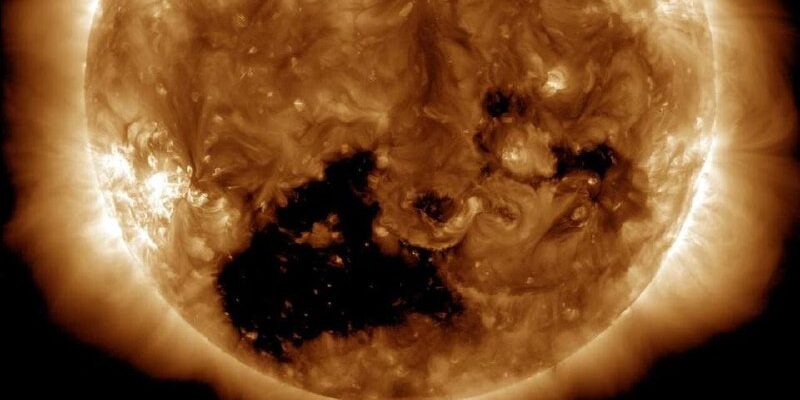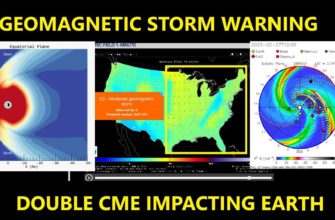MOSCOW – In a celestial event that sounds straight out of a science fiction script, Earth has reportedly plunged “head-first” into a coronal hole on the Sun. This rather dramatic cosmic alignment has triggered an “explosive” increase in solar wind velocity, ushering in a moderate magnetic storm. The update comes from the vigilant watchdogs at the Laboratory of Solar Astronomy of the Space Research Institute (IKI) of the Russian Academy of Sciences, whose latest pronouncements illuminate the dynamic interplay between our star and our planet.
What Exactly Is Happening Up There?
To grasp the significance of this event, one must first understand the enigmatic nature of our star. The Sun is not merely a constant, glowing orb. It`s a dynamic, turbulent entity, constantly shedding particles and energy into space. Among its more intriguing features are coronal holes – vast regions in the Sun`s outermost atmosphere, known as the corona. In these areas, the plasma is cooler, less dense, and magnetic field lines are open to interplanetary space, forming high-speed conduits for solar material. Think of them as open highways through which solar wind escapes.
When Earth aligns with one of these “highways,” as is the case now, we receive a direct hit from high-speed solar wind – a relentless stream of charged particles. While solar flares and coronal mass ejections (CMEs) often grab headlines for their explosive, rapid bursts of energy, coronal holes provide a more sustained, yet equally significant, surge of solar particles. The “explosive growth” in solar wind speed reported by IKI RAN indicates that our planet has entered a particularly potent stream from one such solar opening.
Earth`s Invisible Shield: The Magnetosphere
Fortunately for us, Earth is not a defenseless target. Our planet is enveloped by a powerful, invisible shield: the magnetosphere. Generated by Earth`s molten iron core, this magnetic field extends far into space, deflecting most of the harmful solar wind particles and protecting our atmosphere and everything within it. It’s a remarkable feat of natural engineering, constantly buffeted by the solar wind, flexing and compressing but generally holding its ground.
The IKI RAN laboratory`s latest report noted that the magnetosphere is “holding steady in the green zone.” This implies that while the impact is significant enough to be classified as a moderate magnetic storm, it’s not yet reaching levels that cause widespread severe disruptions. It`s akin to a strong gust of wind hitting a well-built house – noticeable, perhaps rattling the windows, but not threatening structural integrity. For now.
The Terrestrial Ripple Effects of a Cosmic Event
Even “moderate” magnetic storms can have tangible effects on Earth. While the dramatic power grid failures of the 1989 Quebec blackout or the legendary Carrington Event of 1859 are rare, extreme occurrences, lesser storms can still make their presence felt.
Potential Impacts of Geomagnetic Activity Include:
- Aurora Displays: Perhaps the most visually stunning consequence, charged particles interacting with Earth`s atmosphere at the poles can create breathtaking auroral displays, famously known as the Aurora Borealis (Northern Lights) and Aurora Australis (Southern Lights).
- Satellite Disruptions: Spacecraft, particularly those in higher orbits, can experience increased drag, navigation errors, and even temporary electronic malfunctions due to heightened radiation. This could affect everything from GPS accuracy to satellite communication.
- Radio Communications: High-frequency radio transmissions, often used for long-distance communication, can be absorbed or scattered by changes in the ionosphere, leading to signal blackouts or interference.
- Minor Power Grid Fluctuations: While a “green zone” event isn`t expected to cause widespread blackouts, sensitive power grids might experience minor fluctuations as geomagnetic currents induce surges, requiring operators to remain vigilant.
- Biological Sensitivity: Anecdotal evidence suggests some individuals report headaches, fatigue, or other physiological discomfort during strong magnetic storms. While scientific consensus is still developing, the notion of “space weather” influencing human well-being remains a subject of ongoing study and popular discussion.
Monitoring the Unseen: The Role of Space Weather Scientists
This latest alert underscores the critical importance of continuous space weather monitoring. Institutions like the Laboratory of Solar Astronomy are at the forefront, utilizing an array of ground-based observatories and space-based satellites to keep a watchful eye on our star. Their real-time data and predictive models are vital for safeguarding our increasingly space-dependent infrastructure. It`s a cosmic ballet of cause and effect, where a seemingly minor fluctuation on the Sun can, eventually, impact daily life on Earth. The irony, perhaps, is that for all our technological prowess, we remain profoundly reliant on the unpredictable whims of a distant star.
As the moderate magnetic storm unfolds over the next 24 hours, scientists will continue their meticulous observations, providing updates and ensuring that our planet navigates this solar encounter with minimal disruption. It’s a subtle yet powerful reminder of the dynamic universe we inhabit, where cosmic events, however far away, have a direct line to our blue marble.









